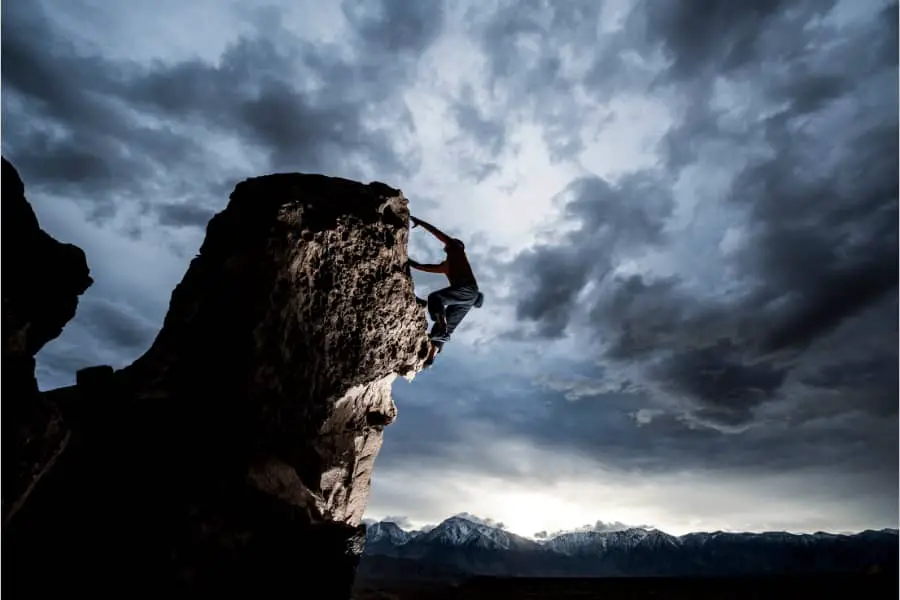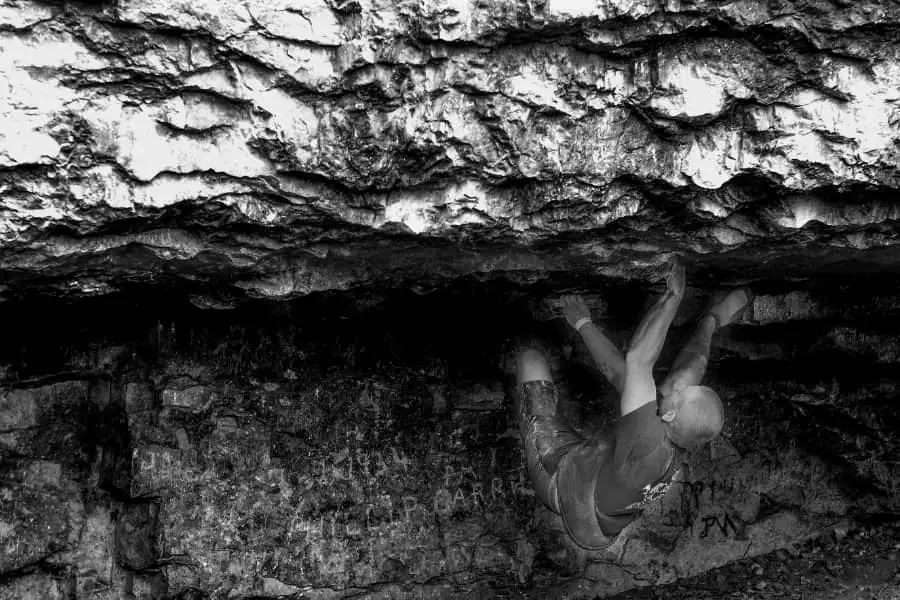
Have you ever had the itch to go climbing but it was downpour raining outside? Well this always seems to happen to me and I personally can only spend so many days in the gym. Eventually, I said screw it, grabbed my climbing buddy and we went out to face mother nature’s wrath.
If done correctly, rock climbing in the rain is possible and very enjoyable. Sheltered routes such as overhangs and routes located in thick forests will generally be protected from the rain. Routes located on igneous and metamorphic rocks with a lot of edges and crimps will be best to climb when wet.
Certain climbing routes will be more affected by the rain than others. The trick is to know which routes will still be climbable during or after a heavy rain event. A multitude of variables determines this such as the rock type, hold types, route geometry, and surrounding environment.
If you are interested in seeing what the current prices are for the most popular rock climbing shoes, you can find them on Amazon by clicking here. Using the Amazon affiliate link above and/or other links in the article helps support this website.
How Rain Affects Rock Climbing
Two main factors determine how much your climbing experience is affected by the rain:
- What route(s) you are hoping to climb
- How prepared you are to tackle the session
Why Picking The Right Route Matters
Rain is going to affect any route you choose to climb to some extent. Wet rock will provide you with dramatically less friction than dry rock. This is going to make the route slick and slippery. Pinches you once were able to easily grasp are now more slippery than a greased pig. Slopers you were handling like nobody’s business now will keep you up at night.
Climbing soaked routes in the middle of a downpour can be dangerous. The holds will be slippery which can lead to unexpected falls. Taking unexpected falls are one of the most dangerous things in climbing. In addition to this, wet rock will be colder than you are used to. This will cause your hands to lose heat and eventually become numb if you are not able to warm them up frequently enough. Everything seems to hurt more when your hands are cold.
How To Properly Prepare For Climbing In The Rain
That being said, all hope is not lost. You can prepare yourself to help counter act these unfortunate side effects of climbing during a rain storm. To do this, choose what routes you will be climbing very wisely. Also, go into your session with an incredibly psyched attitude.
Although every route will be affected by the rain, some routes will be less affected than others. The key is to pick the routes that will be least affected and go climb those.
Climbing in the rain has its challenges but it can be a blast if done correctly. Having an overall positive attitude will enhance your climbing experience. You should be excited to try climbing in the rain once you have determined which routes to give a go.
How To Pick Which Routes To Climb In The Rain
Four main factors determine how much the route will be affected by rain:
- The geometry of the route
- The route’s exposure level
- The rock type the route is located on
- The hold types comprising the majority of the route
How Route Geometry Affects Climbing In The Rain

The angle of the rock face will dramatically affect which routes will become wetter than others. Routes at angles less than 90 degrees such as slabs will be subjected to more water than vertical faces. On top of this, runoff could create streams of water along the slabs making the route even more difficult to climb.
Vertical faces will not get as drenched as slabs; however, they will be more affected than overhangs. Overhangs are the ideal routes to climb during or after rain events. They will be the most protected routes from the elements and will therefore be the driest available.
How Surrounding Environment Affects Climbing In The Rain
Rain affects routes on completely exposed cliff faces with no vegetation or other environmental features around to protect them the most. Routes located in dense forests or in more sheltered areas will be better to climb after or during a rain event. The rock face will be more protected from the weather conditions and won’t become as wet as the surrounding areas.
Look for routes in dense forests that are sheltered by the surrounding trees and structures.
How The Rain Affects Different Rock Types
Rocks with low porosity (the amount of void space between the minerals) will be less affected than rocks with higher porosities. This is because water is able to intrude and soak rocks with high porosities easier than rocks with low porosity.
High porosity rocks are generally sedimentary. Examples of these include sandstones, limestones and conglomerates.
Low porosity rocks are generally metamorphic and igneous. Examples of metamorphic rocks are slate, schist, and quartzite. Examples of igneous rocks include granite, basalt, and diorite.
Metamorphic and igneous rocks are the best types of rock to climb during or after a rain event because they will become less wet and dry out quicker than sedimentary rocks like sandstone.
Which Hold Types Are Best On Wet Rock
Routes mainly composed of crimps, edges and jugs will be best to climb when wet. Holds with faces parallel to the ground (perpendicular to the rock face) will be the easiest to grip when wet. This is because these holds do not require a lot of friction to use. As stated previously, wet rock has less friction than dry rock.
Try to avoid routes with a high density of slopers and moves that require smearing. Slick rock is not your friend in these circumstances.
Tips For Climbing In The Rain
If you have never gone climbing in the rain before, I recommend trying it at least twice. The first time to see what it is all about and have a new climbing experience. The second time to actually go out and have fun once you have identified a few areas that could be improved upon.
Below are a few things I have learned from climbing in the rain:
- Don’t use chalk. When you are climbing in wet conditions and on wet rock, your chalk WILL get soaked. If you have never experienced wet chalk, try getting a little bit wet and put it on your hands. It becomes a weird gooey mess and it looses all of its effectiveness for climbing. Nothing is worse than wet chalk.
- Bring a thermos full of boiling water. Your hands will become cold and wet being outside in the rain and climbing wet rock. Boiling hot water ahead of your trip and keeping it in a thermos will keep your hand warm and prevent you from spending needless money on hand warmers.
- Wear a baseball cap or a hat with a brim. When climbing your route, you will need to look up at times. Looking up when it is downpour raining is easier said than done. Wearing a hat with a brim will help to keep the rain out of your eyes when on the route.
- Attempt easier routes than you normally would. The conditions will effect any route you pick to a certain extent. Climbing wet, slippery rock with cold hands will decrease your ability to climb at the same level you are used to. This can be an opportunity to try out new routes you have never attempted before!
- Bring an equally psyched climbing partner. Being outside in cold wet conditions for extended periods of time can be miserable for even the most dedicated climbers. Having an enthusiastic and excited climbing buddy is always a necessity and even more so during less than ideal conditions.
- Bring spare dry clothes and towels along. Your session will leave you thoroughly soaked by the end. Nothing feels better than drying off and putting on warm, dry clothes after a sick rain session.
The bottom line? Climbing in the rain is possible and will provide you with a unique climbing experience. Be sure to pick your routes wisely and bring a fun climbing buddy along for the ride!
